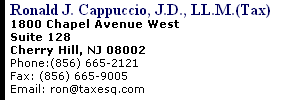Although
higher interest rates and other factors have put a damper on
the residential real estate market this spring, the prime
selling season is in full swing for many owners. So this is a
good time to review how taxes will factor into the transaction
— if and when you decide to sell your property. With the home
sale gain exclusion tax break, the
|
Average
Mortgage Interest Rates
|
Week
ending |
30-year |
15-year |
| June
8, 2006 |
6.62 |
6.23 |
| March
16, 2006 |
6.34 |
5.98 |
| January
12, 2006 |
6.15 |
5.71 |
| 2005
annual average |
5.87 |
5.42 |
| 2004
annual average |
5.84 |
5.21 | Source:
Freddie Mac Weekly Mortgage
Survey | |
|
Reduced Exclusion
Might Apply To
“Premature” Sales
You generally cannot claim the federal home sale gain
exclusion break if you fail either the ownership test or
the use test explained in this article. Also, you
generally cannot claim an exclusion for a sale that
occurs less than two years after an earlier sale for
which you claimed an exclusion.
The key word here is generally, because there’s a
favorable exception that might help when you make a
“premature” sale that fails to meet the basic timing
rules. Specifically, you can claim a reduced exclusion
if your premature sale is primarily due to:
1. A change in place of
employment.
2.
Health reasons.
3. Certain unforeseen circumstances outlined in
IRS regulations.
For example,
let's say you and your spouse own and use a home as your
principal residence for 18 months. You are forced to
sell because your job is transferred to a distant state.
Under these circumstances, you would qualify for a
reduced gain exclusion of $375,000. This is 75 percent
of the full $500,000 joint-filer exclusion, because you
owned and lived in the home for 75 percent of the
required two-year period.
Bottom Line: If you qualify for the reduced
exclusion, it can be generous enough to completely
shelter your profit from federal income tax.
|
profit from selling your
principal residence might be free from federal income taxes
(and possibly state income taxes too). The rules are
straightforward for most sellers.
Basic Qualifications
Under the Tax Code
An unmarried homeowner can potentially sell a principal
residence for a gain of up to $250,000 without owing any
federal income tax. If you’re married and file jointly, you
can potentially pay no tax on up to $500,000 of gain. To
qualify, however, you generally must pass two tests:
 Ownership
Test - You must have owned the
property for at least two years during the five‑year period
ending on the sale date.
Ownership
Test - You must have owned the
property for at least two years during the five‑year period
ending on the sale date.
 Use
Test - You must have used the
property as a principal residence for at least two years
during the same five‑year period (periods of ownership and
use need not overlap).
Use
Test - You must have used the
property as a principal residence for at least two years
during the same five‑year period (periods of ownership and
use need not overlap).
To be eligible for the maximum $500,000 joint-filer
exclusion, at least one spouse must pass the ownership test,
and both spouses must pass the use test.
If you excluded a gain from an earlier principal residence
sale under these rules, you generally must wait at least two
years before taking advantage of the gain exclusion break
again. If you’re a joint filer, the $500,000 exclusion is only
available when neither you nor your spouse claimed an
exclusion for an earlier sale within two years of the sale
date in question.
Tip: If you make a "premature" sale that fails to
meet the preceding timing rules, don’t give up hope. You may
qualify for a reduced exclusion that will be large enough to
shelter your entire gain from federal income tax (see
right-hand box)
Beware if
You Engaged in a Tax-Free Rollover Under the Old
Law: Back in the days before the current gain
exclusion break existed, did you avoid paying federal income
tax by rolling over a home sale gain into the basis of the
residence you are now about to sell? Watch out if you did so
(under former Internal Revenue Code Section 1034).
The gain on your current residence may be much higher than you
think. Why? Because the profit you rolled over under old law
(before May 7, 1997) reduces the tax basis of your present
home for gain calculation purposes.
Example: Let's say you and your spouse rolled over a
$350,000 gain from a 1995 home sale into the basis of your
current home which cost $550,000. You’re now getting ready to
sell that home for an expected $975,000. You may think your
gain will be only $425,000 ($975,000 sale price minus $550,000
cost). That $425,000 gain would be federal-income-tax-free,
thanks to the generous $500,000 joint-filer exclusion.
Unfortunately, it’s not quite that simple. The correct gain
for tax purposes is $775,000 ($975,000 sale price minus
$550,000 cost basis plus the $350,000 gain rollover that you
did under the “old law”). So even if you qualify for the full
$500,000 joint-filer exclusion, you would still have a taxable
profit of $275,000 ($775,000 gain minus $500,000 exclusion).
Even so, this is hardly bad news, because it means you made
lots of money on your two home sales.
In most cases, the federal home sale gain exclusion rules
are generous enough and fairly simple too. However, as with
all tax breaks, things can get complicated if your situation
is the least bit out of the ordinary. Your tax adviser can
tell you if your deal will be federal-income-tax-free and help
you plan for the best tax results.









